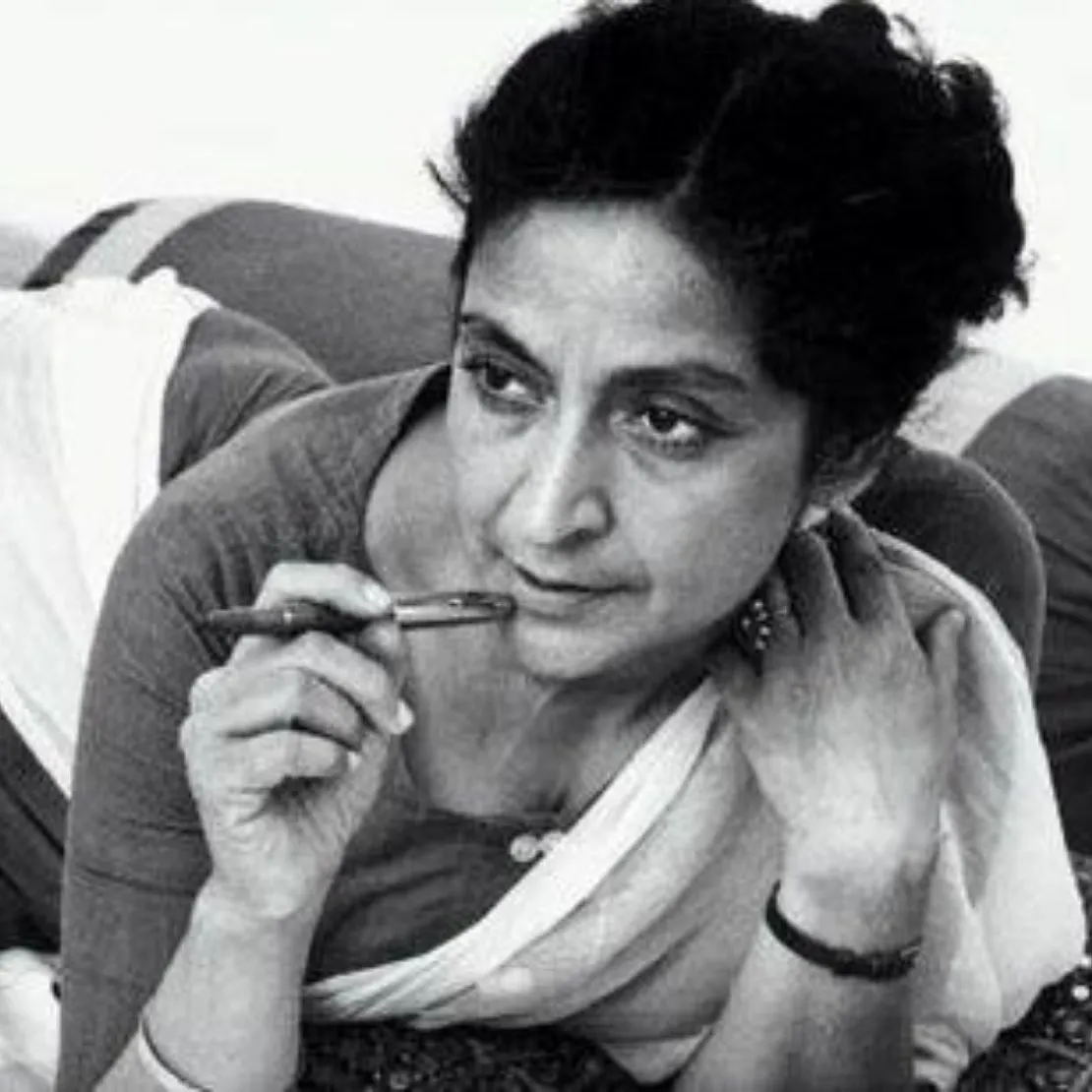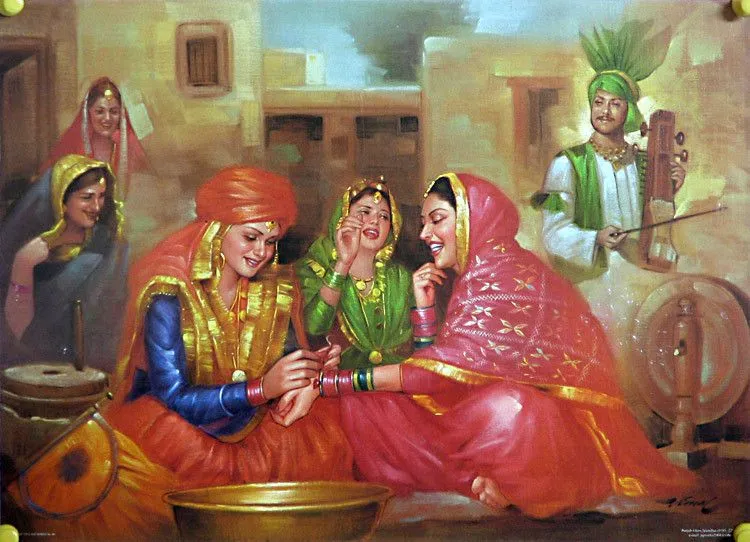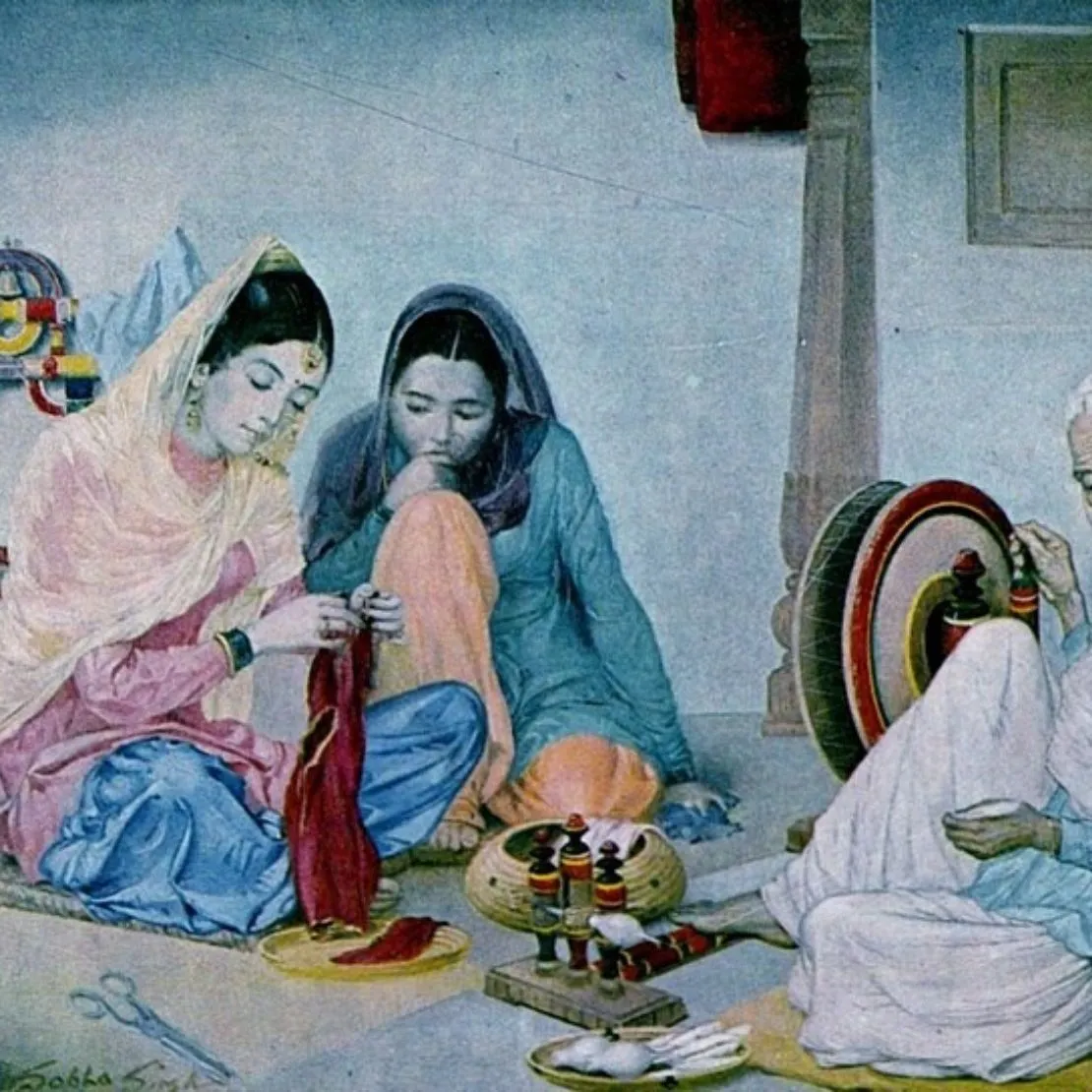Kissing Punjab's history with Phulkari through Amrita Pritam's lyric
Mama and I sit in the sun. I open the shell of a ripe bael, and start separating the pulp.
She opens her old peti, which has her wedding trousseau. She inspects the garments for defects, untrimmed threads and missing stitches; this is something she does now and again.
I see her separating a shawl with Phulkari from this pile. Phulkari (Phul = flowers; Kari = work) is the folk embroidery of Punjab with gorgeous flower-work done on the cloth. The designs are involved and have complex patterns. To make them is an exacting task, which is typically reserved for and assumed during lavish festivities like weddings. In particular, the bride’s shawls and stoles are embroidered, which the family uses as a canopy for her during the ceremony. This article of clothing is showy and has a riot of colour. Amrita Pritam mentions it in her work, writing about an embroidered shawl similar to my mama’s, but hers is made of moonbeams.

Celebrated Punjabi poet & feminist, Amrita Pritam
Pritam’s poem “A Shawl Made of Moonbeams” has a discernible mood. But it is not elation that, I suppose, comes from anticipating a wedding or would associate with the description of rich and deep-coloured clothes. Rather, the poem has a quality which qualifies as heartache and grief. Pritam’s lover has left her. She is upset, very downcast. When she mentions the shawl, she wonders, “Who will put a stitch in it to complete the design?” Because her lover has left, her occasion to wear a Phulkari is gone. Now, Pritam thinks it is idle for even the moon—a firm favourite image with romantic poets—to muse on a wedding. Instead, any construction of trousseaus is paused, and all the world’s embroidered designs remain incomplete.
The first text to mention Phulkari has a similar emotional effect. It is Waris Shah’s tragic romance Heer Ranjha. Shah describes the Phulkari embroidered on Heer’s trousseau. Heer, however, never gets to be clothed in this rich array. Misfortune strikes and the play’s antagonist kills her on her wedding day. Her embroidered shawls and stoles are never put to use. This tinges Phulkari with tragedy in this literary tradition. Pritam’s register is part of it, she strongly indexes Shah’s mood. In fact, I propose that throughout the poem she makes diffused associations with the image of an unfinished Phulkari to describe her lost love, although she never overtly refers to it and seemingly starts to describe the lawns and landscape in spring in the next stanzas.
.webp)
A Punjabi girl running with her Phulkari through the fields | Artwork produced by our designer Mahima Chavan
But in another poem, “Today I invoke Waris Shah”, Pritam laments that Shah only narrates Heer’s ill-fate and sorrow in his tragic romance, taking no notice of the other daughters of Punjab who suffer. She implores him to “turn to the next page in your book of love”, and pen their suffering as well. In “A Shawl”, I believe that Pritam turns this page herself. Because of her tragic miscalculation in the affairs of love, she is in pain, and when she is in pain, she writes of it using the Phulkari as her image.
Pritam’s image of the moonbeams making a mundane shawl is uncommon, and also an anacoluthon, which means that when she starts to speak of it there is an unexpected discontinuity in her expression of the idea. The idea of the shawl remains incomplete like the design it depicts as she stops analysing the moonlight to instead attend to the details of other celestial phenomena. In the next line, Pritam writes
Amber da ek aala sooraj baal deyan
Man di uchi mamti deeva kon dharey
which translates to “I can reach the alcove of sky / To light the sun / But the terrace of mind is too high / Who shall light its lamp!”, implying that the sky is no longer faraway; it is a mundane recess in the wall that she can easily light.
Amber ganga hundi gaagar bhar dendi
Dardaan da dareyao,kheda ghut bharey
She continues: “With the stars of the Milky Way/ I would have filled my cup / But from the river of pain / Who would want a drop!” A galaxy is not an awe-inspiring cluster of stars. Rather, it is a mere hazy band of light that she can pour in her everyday cup.
Pritam has thrice undertaken the same developmental process in the first stanza of “A Shawl”.
First, she notices a natural object in the sky: the moon, the sun, the sky, the galaxy. Then, she domesticates her raw observations by imbuing them with human description: her moon makes a shawl, the sky is an alcove, the sun becomes a lamp, and the galaxy is a drink. Her doing so is like a chemical or industrial treatment that preserves these celestial objects in her poetry. As a consequence, in the next line, which is the final step of her process, she is able to extract from the natural phenomena a fitting reservoir of imagery to describe herself. In particular, she scales down descriptors of the cosmos to present her world in the second part of the paired constructions. For example, she extracts “lamp” from the sun to then manufacture her heart as one. If her verse-making resembles an industrial process, this is her finished good.
I can reach the alcove of sky
To light the sun
But the terrace of mind is too high
Who shall light its lamp!
Pritam’s paired constructions (1. and 2.) are roughly equal in length and of a similar grammatical structure. This balance makes the conditions of her heart compare with the cosmos, thereby commenting on the significance of the former. To be specific, she elevates her loss by putting a spotlight on the second conjunct (2.) She does so by making (2.) the logical complement of that which precedes it (1.); in other words, Pritam persuades the reader that her worries are more valid through the insertion of an imaginary but: She is able to light the lamp-like sun but her heart is in darkness. She can pour the liquid stars in her glass but she can’t swallow her tears.
A norm has been set up. This I cite as
1. Pritam’s description of celestial patterns in human terms,
2. Her carrying over that descriptor to the second phrase, and then,
3. Inversing it to describe herself.
As she described the moonlight making an incomplete shawl, there is a strong expectancy from her to extract the word “shawl” from this description. The poetess should contract its size in the second phrase to present something personal as an embroidery which is complete. However, the stanza ends, and no such comparison follows. Instead, she starts describing the landscape of Punjab during the Chaitra and the Vaisakh month. Both correspond in the Gregorian calendar to a day in April or May, and to the spring season basant. Here, I propose that as Pritam did not complete her industrial treatment to preserve “shawl” in her poetry, her reservoir of imagery is raw. As a result, she has to describe all aspects of Phulkari in its natural and unprocessed form.

Punjabi woman in red Phulkari (right) during wedding preparations | Source: Unknown
For example, Phulkari is embroidered on the fabric of khaddar. It is a hand loomed plain-weave coarse cotton cloth. Cotton is grown throughout the Punjab plains. Because Pritam does not carry her industrial process when she describes the landscape and plains in the stanzas, I take that as per the logic of her poem she is actually describing the fabric in its unprocessed appearance; her fields are meant to be the cotton cloth in its macrocosmic form on which she will embroider. The poetess begins by painting the scenery of basant
Chetar ne pasa modeya
Chetar ne pasa modeya
Ragaan de mele vaastey
Phullan ne resham jodeya
Tu nahi aya
Hoyian dupehran lamiyaan
Hoyian dupehran lamiyaan
Dakhaan nu laali cho gayi
Daati ne kanakaan chummiyan
Tu nahi aya
In her fourth line, she writes, “The flowers have collected fabric”. Typically, during basant, the cotton crop starts to flower. These flowers collect fibre. Their petals change colour from creamy white to yellow, from yellow to pink and finally, scarlet. After three days, they wither and fall. In the inner part of the bloom, some green pods are left, which develop into a fruit-like cotton boll. Moist fibres push out from its newly formed seeds. They expand under the warm sun. Finally, they split the boll apart and the fluffy cotton bursts forth. This indicates that the crop has matured, and harvesting can begin. As a consequence by the time Pritam reaches the last two lines (9. And 10.), she mentions her every part of this field has been sickle kissed. A sickle is a curved, hand-held agricultural tool. Its inside of the curve is the cutting edge, which is serrated. The farm-hand swings the blade against the base of the crop, cutting through the stems. Then, they remove the bolls of cotton from the stalk. The de-seeded cotton is cleaned, carded, spun, and woven into khaddar.
Next, in the method of making the phulkari design, the khaddar is laced with straight strokes of thread. This embroidery is done by manipulating a darn stitch. A darn stitch is made by running the needle and the thread unidirectionally either solely to the left or to the right of the fabric. In particular, two distinct sets of yarn are woven in-and-out of the ground fabric. The longitudinal threads are called the warp. The lateral threads are the weft or filling. They are then interlaced at right angles. These resemble the small parallel channels or furrows that would be dug in Pritam’s field as before planting cotton, the planter opens a furrow in each row, drops in the right amount of seed, and packs the earth on top of them. The shawl made of moonbeams finds meaning in the angularity of these lines on ground.

Punjabi women working on fabrics together | Historical painting by Sobha Singh
People use darning to mend torn clothes. While using this functional stitch, the embroiderers, who are typically women, count both the warp and weft threads, and vary the length of their stitches. This creates a geometric figure, and they can make vivid patterns by enlarging it. The women take cues from anything around them to select their patterns. Commonly, they replicate on the cotton cloth their tryst with the flora in their fields. In their designs, roses and marigolds are widespread; foliage is loved dearly, and the word “phulkari” meaning floral work comes from this.
Bagh is the most prominent form of Phulkari work. It is the word for garden. The embroidery is done so profusely, that the khaddar base is scarcely visible. In “A Shawl”, Pritam represents a Bagh in Vaisakh during Basant, planting one garden image on top of another. This technique of description resembles the tender touch of the needle and thread, as it would round a petal or guide a leaf. The poetess talks of ships of white that sail in the blue above, and send rain and warm wind to the brown soils. As a result, the roots are quenched, the soil is renewed.
Dharti ne bukkaan jod ke amber di rehmat pee layi
Tu nahi aya
Rukhan ne jaadu kar leya
Rukhan ne jaadu kar leya
Jungle nu chohndi paun de honthan ch
shehad bhar gaya
This awakens the seeds. Wild flowers rise and start to grow interspersed between the furrows of the cotton field.
Because the darn stitches are made at right angles in the Phulkari, even threads of the same colour contrast in their shades, depending on how light falls on them. This animates the flower work done on the cloth, instilling more life and texture to the embroidered garden. Thus, in Pritam’s poem, when at night time a silver tideline of the moonlight falls on her furrows and fields and illumines it, against the blackness of the rest of the nightscape, she reckons it appears to make the shawl, but one that has its final stitch incomplete.
Once Pritam has described the moonlight falling on the earth as all aspects of Phulkari-making, her industrial process of limning celestial patterns in human terms is complete. Now, the obligatory formulaic parallelism continues. She can preserve this image, extract the word “shawl” from it, contract its size, and inverse it to present her shawl as complete. The poetess writes
Chetar ne booha khadkaya
Kalam kudi de bulh kumlaye
The time is Chaitra again, indicating that what follows is synchronous to that which was taking place in the fields. Her lips wither (“kumlaye“) and bleach into paleness. This verb is commonly used to describe flowers. Pritam diction makes me think that she is drawing a parallel between her lips and the cotton flowers that wither and fall during the same month to collect fabric.
Ajj da geet is tarah baneyaa,
Jivein chubde zakhmaan vichon,
Lafzan de kuch topey kholey
Dil de saarey varkey thulley
These lips yield words (“lafzan”) that are like yarn (“topey”); she fiddles with them, they turn and twist and then burst forth as from a cotton boll. Because Pritam’s lover had left and her heart aches from pain, she writes in line 2. that it now has wounds and rips. But she decides to darn those and rebuild the weft and warp of the worn-out area by weaving the story of her heartache and grief (“lafzan de kuch topey kholey”). By sharing her story, Pritam mentions that she is able to fill pages (“saare varkey thulley”), which is something she had implored Shah to do in her other poem.
Actually, when women assumed the exacting task of embroidering a Phulkari, they would invite friends and family, and Pritam alludes to this activity. During the long hours of weaving, they would hand-down stories to pass their time, and carry emotional engagements, exploring shared threads of feeling with one another.
As a consequence, when the moonlight falls and traces the silhouette of an incomplete shawl, the poetess finds solace in completing this another metaphorical shawl that mends her heart’s wounds.